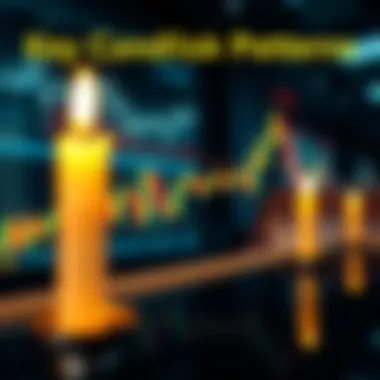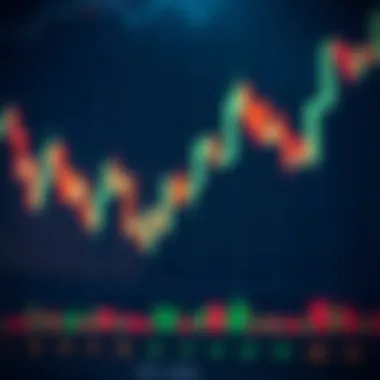Mastering Candlestick Analysis for Cryptocurrency Traders


Intro
In the fast-moving world of cryptocurrency, understanding market dynamics is crucial for success. One essential skill that traders and investors need to master is candlestick analysis. It offers an intuitive way to visualize price movements, helping to predict future market behavior. However, for beginners, this concept can seem daunting.
By breaking down the components of candlestick charts, identifying key patterns, and learning effective strategies, this guide aims to provide a solid foundation in candlestick analysis. Whether you're a trader trying to optimize your strategies or an analyst seeking deeper insights, understanding these charts can significantly improve your decision-making process.
Let’s dive right into the elements that shape the world of cryptocurrencies, starting with the concepts that underlie market behavior.
Understanding Candlestick Basics
Understanding the fundamentals of candlestick charts provides a solid foundation for anyone venturing into trading, especially in volatile markets like cryptocurrencies. Candlestick charts capture not just the price movement but also market sentiment, enabling traders to make informed decisions. This section lays out the essential concepts that every beginner must grasp to navigate the intricate waters of trading successfully.
What is a Candlestick?
A candlestick is a graphical representation of price movements over a specific time frame. Each candlestick illustrates four key data points: the opening price, closing price, high, and low for that particular period. Candlestick charts not only offer a visual insight into market trends but also allow traders to interpret the psychology behind price movements.
Components of a Candlestick
Delving deeper into candlestick analysis, it’s essential to break down its components. Each part serves a unique purpose, contributing to a trader's understanding of market dynamics.
Body
The body of a candlestick is formed between the open and close prices. A long body typically indicates strong buying or selling pressure, while a short body suggests a balance or indecision in the market. This aspect is crucial as it reflects the strength of the prevailing trend, thus aiding in predicting future price movements. The body is arguably one of the most notable features since it reveals the intensity of market participants' commitment at any given time.
Wicks
The wicks, or shadows, extend above and below the body of the candlestick. They represent the highest and lowest prices reached during that time frame. Wicks can often provide insight into potential reversals; for example, a candle with an upper wick that is significantly longer than the body can indicate that buyers pushed prices up, but sellers entered the market aggressively, pulling prices back down. Understanding the length and position of these wicks gives traders an edge in gauging market sentiment.
Open and Close Prices
The open and close prices are vital indicators of market sentiment over the time span represented by the candlestick. The opening price reflects where the market began for that period, while the closing price indicates where it ended. If the closing price is higher than the opening price, you have a bullish candle; if it is lower, it’s bearish. This dynamic can give traders a quick snapshot of market direction and can be pivotal in decision-making processes.
Color Codes: What Do They Mean?
Candlestick patterns are often color-coded to represent bullish and bearish movements. Typically, a green or white candle indicates a closing price higher than the opening price, while a red or black candle signifies a closing price below the opening price. These colors are more than just aesthetic; they convey immediate information about price trends and can help traders make quicker assessments about market conditions.
The Significance of Candlestick Patterns
Understanding candlestick patterns is crucial for anyone delving into the world of trading, especially in volatile markets like cryptocurrencies. By learning to read and interpret these patterns, traders can make sense of price movements and gauge market sentiment. This section will highlight why individuals should incorporate candlestick analysis into their trading arsenal.
Why Use Candlestick Charts?
Candlestick charts offer a visual representation of price movements over specific time frames, making them a popular choice for traders. The key benefits of candlestick charts include:
- Intuitive Design: Unlike traditional line charts, candlestick charts communicate more information in a compact format. Each candlestick represents open, close, high, and low prices, allowing traders to quickly assess market conditions.
- Ease of Interpretation: Patterns within candlesticks can signal potential trends. Recognizing these patterns can give traders the edge they need to make informed decisions. For instance, a Doji candlestick often indicates indecision in the market, prompting careful analysis before executing a trade.
- Enhanced Decision-Making: By providing a clearer picture of market psychology, candlestick charts can help traders anticipate potential reversals or continuations in price action. This is particularly helpful in the crypto market, where rapid price fluctuations can easily catch traders off guard.
Leveraging candlestick charts can make a substantial difference in trading outcomes. As a forex trader once noted, "Charts are a trader's map; the candlestick patterns are the road signs." Thus, it is prudent for newcomers to familiarize themselves with this essential tool.
Interpreting Market Sentiment
Reading candlestick patterns goes beyond analyzing price captures; it is about understanding the market participants' emotions at a glance. Different patterns reveal various sentiments:
- Bullish Sentiment: When buyers dominate the market, forming patterns like the Bullish Engulfing, it signals confidence in price sustainment. Traders keen on spotting these trends can position themselves to ride the market up.
- Bearish Sentiment: Patterns like the Three Black Crows indicate sellers' control, suggesting that prices might continue to drop. Acknowledging these signals can enable traders to adjust their strategies accordingly.
"A trader's ability to read the mood of the market can be as crucial as understanding the technicals."
In volatile fields such as cryptocurrency, sentiment can shift dramatically in a matter of hours. Therefore, being attuned to changes in market sentiment is vital. Particularly, new traders should avoid the pitfall of solely focusing on price without understanding the underlying emotions driving market behavior.
In summary, the intricacies of candlestick patterns provide essential insights into the market's mood. Recognizing these patterns and utilizing them effectively equips traders with the tools necessary to navigate the often-chaotic world of trading. Understanding these nuances can lead to improved decision-making and enhanced performance, ultimately setting traders on the path to success.


Common Candlestick Patterns
Candlestick patterns serve as a unique visual language that traders use to communicate with the market. Recognizing these patterns can illuminate the psychology behind price movements, providing insights about potential reversals or continuations in market trends. Understanding this aspect is key because, in the world of trading, patterns can signal critical moments when decisions need to be made. Patterns like the Doji or the Engulfing can help traders make educated guesses on where the market might head next. This offers a systematic approach to navigating the chaotic waters of trading, particularly for those new to the field.
Doji Candlestick
A Doji candlestick is a peculiar formation that signals indecision in the market. It occurs when the opening and closing prices are virtually equal. The appearance of a Doji can suggest that the buyers and sellers are in balance, leading to a pause or reversal in the prevailing trend. This structure is like a wake-up call for traders; noticing a Doji might encourage them to reassess their positions.
In practice, a Doji appearing after a trend upward could indicate that momentum is waning, hinting at a possible downturn soon.
Hammer and Hanging Man
The Hammer and Hanging Man are two sides of the same coin, both signaling potential reversals but appearing in different contexts. The Hammer is typically found at the bottom of a downtrend and looks like a small body with a long lower wick. This indicates that the market tested lower prices, but buyers stepped in, pushing the price back up. It’s a hopeful sign for bullish traders.
In contrast, the Hanging Man appears at the top of an uptrend. Although it looks similar to the Hammer, its implications are more bearish. A Hanging Man suggests that sellers might be gaining strength. Traders should watch for confirmation in subsequent candles, as this will lend weight to the signals these patterns provide.
Engulfing Patterns
Engulfing patterns are critical in candlestick analysis, as they showcase a strong shift in market sentiment. This pattern consists of two candlesticks: a smaller body followed by a larger body that entirely engulfs the first one. Understanding these can enhance trading strategies significantly.
Bullish Engulfing
A Bullish Engulfing pattern occurs at the end of a downtrend and involves a green candle that completely engulfs the preceding red candle. This pattern signifies potential buyer strength emerging. It’s beneficial for traders because it often forecasts a price increase ahead. Recognizing this pattern may prompt traders to enter a long position, expecting a rise in market prices. However, traders should exercise caution, as this pattern requires confirmation by subsequent bullish candles for the best accuracy.
Bearish Engulfing
On the flip side, a Bearish Engulfing pattern happens at the conclusion of an uptrend, with a red candle enveloping the previous green candle. This indicates that sellers are taking control, suggesting a potential downtrend ahead. As a popular choice in analyzing market behavior, it can help traders decide to close long positions or consider entering short positions. Yet, much like the Bullish variant, waiting for further confirmation through ensuing candle formations is crucial before making a definitive trading decision.
Shooting Star and Inverted Hammer
Both the Shooting Star and Inverted Hammer signal reversals but found in different trends. A Shooting Star features a small body and a long upper wick, indicating the buyers pushed prices high within the session, but sellers took over and forced prices down by closing near the session's low. Found at the top of an uptrend, it can be a hint that the tide is turning. Conversely, the Inverted Hammer appears in a downtrend and has a similar shape. Here, despite a struggle to go higher, the buyers manage to raise the price a little, leading to possible reversal signals. Monitoring these shapes alongside other indicators can provide better context to where the market might be heading.
Understanding these patterns is not merely about identifying shapes on a chart. It's about interpreting market sentiment and deciding whether to navigate cautiously or dive right in.
In summary, the realm of candlestick patterns is rich with insights that allow traders to read market conditions effectively. By mastering the common patterns discussed, new traders can better position themselves to handle market fluctuations with confidence.
Advanced Patterns and Their Implications
Understanding advanced candlestick patterns is crucial for traders who want to deepen their analytical skills. These formations can provide rich insights into market sentiment and potential future movements. While basic patterns set the groundwork, advanced patterns help you add to your trading arsenal, refining your strategy and enhancing your decision-making capabilities. Let's explore two notable advanced patterns: the Morning Star, Evening Star, Three White Soldiers, and Three Black Crows.
Morning Star and Evening Star
The Morning Star is a bullish reversal pattern. It's composed of three candlesticks. The first one is a long bearish candle, signaling a continued downward trend. The second candle is a smaller body, which can be bullish or bearish, that indicates indecision in the market. Finally, the third candle is a long bullish one that typically closes well above the middle candle's body. This pattern indicates a potential trend reversal from bearish to bullish, suggesting that buyers have taken control.
Conversely, the Evening Star serves as a bearish reversal pattern, consisting of the same three elements but flipped in the opposite direction. It begins with a strong bullish candle followed by a smaller-bodied candle. The final candle is a long bearish one that closes below the body of the previous candle, signaling that sellers may be gaining strength and a trend reversal from bullish to bearish is possible.
In trading, pattern recognition can make a world of difference. Developing the ability to spot these formations early is invaluable.
Three White Soldiers and Three Black Crows
The Three White Soldiers pattern features three consecutive bullish candles, each closing higher than the last. This pattern suggests a strong reversal, usually following a downtrend. The implication here is clear: buyers are stepping in with force, indicating potential for continued upward momentum. Traders often look for confirmation through volume increases during this formation.
On the flip side, the Three Black Crows pattern consists of three consecutive bearish candles and is the opposite of the Three White Soldiers. Each candle opens within the body of the previous candle and closes lower. This pattern indicates strong selling pressure and can often mark the beginning of a downtrend, especially after a bullish rally. Recognizing this pattern allows traders to anticipate potential market shifts and manage their positions accordingly.
In each of these patterns, counting the candlesticks is just the start. Evaluating the overall market conditions and using them in conjunction with other indicators, like moving averages or volume analysis, can provide a clearer picture of what to expect.
Remember, while advanced candlestick patterns can be potent indicators, they’re not foolproof. Always keep an eye on broader market conditions to make more informed trading decisions.
Using Candlestick Analysis in Trading


Candlestick analysis is not just a tool for basic market understanding—it’s a fundamental aspect of developing a robust trading approach. Grasping candlestick patterns can sharpen your strategic edge when navigating the unpredictable waters of cryptocurrency and other financial markets. By looking beyond mere price movement, traders can tap into market psychology and sentiment. Recognizing price trends becomes less about guesswork and more about informed decision-making.
Creating a Trading Strategy
When pounding the pavement of any trading landscape, flexibility is essential. A trading strategy serves as your compass; it guides your decisions in both calm and stormy waters. Integrating candlestick patterns into your strategy can significantly elevate its effectiveness. Here’s how:
- Set Clear Goals: Define what you seek: short-term gains, long-term stability, or both?
- Risk Assessment: Understand your risk tolerance and what you’re willing to lose before entering a trade.
- Combination of Patterns: Identify various candlestick patterns and use them in conjunction. For example, a bullish engulfing pattern could serve as an entry signal, whereas a doji might signal caution or indecision.
- Testing: Back-testing strategies over historical data can provide insights into how well they might perform under different market conditions.
In the end, a well-crafted trading strategy that incorporates candlestick analysis can give traders more control over their investment journey.
Combining Candlestick Analysis with Other Indicators
To fully harness the potential of candlestick analysis, it’s wise to pair it with other technical indicators. This combination can provide a slice of clarity amidst chaotic price movements.
Moving Averages
Moving averages (MA) are an evergreen tool in a trader’s toolkit. They serve to smooth out price action, helping highlight longer-term trends while filtering out the daily noise. Candlestick patterns can often provide entry and exit signals, while moving averages solidify these decisions.
- Key Characteristic: MAs can either be simple (SMA) or exponential (EMA), each having unique strengths. For instance, EMAs react more sensitively to recent price changes than SMAs, making them advantageous during volatile market phases.
- Benefits: Pairing candlestick patterns with MAs aids in confirming trends. If a bullish engulfing pattern appears near an upward-sloping EMA, it signals strength and could validate a buying decision.
- Considerations: Relying solely on moving averages can sometimes mislead; a sudden market reversal can happen. Always integrate them with other indicators for more effective analysis.
Volume Analysis
Volume serves as a telltale sign of market health and can be a game changer when combined with candlestick charting. Understanding the relationship between price movements and trading volume can offer deeper insights into market trends.
- Key Characteristic: Volume measures the number of units traded in a specific timeframe. A spike in volume often accompanies significant price changes, providing context to candlestick patterns.
- Benefits: When you see a candlestick pattern, such as a bullish engulfing pattern, coupled with a notable increase in volume, it may suggest strong support for the price movement. This further reinforces your trading decision.
- Drawbacks: While useful, volume analysis can also mislead. A high-volume spike without clear direction can indicate uncertainty. Thus, context matters—don't overlook fundamental and news events influencing volume.
Risk Management with Candlestick Patterns
Navigating the turbulent waters of trading requires more than just knowledge of market trends; it's crucial to grasp the importance of risk management, especially when using candlestick patterns. This section delves into the strategies that can help traders protect their investments when they analyze these charts. Risk management serves as a safety net, enabling traders to set boundaries and limits that are instrumental in their journey through the financial markets.
Setting Stop Loss Levels
One of the most effective ways to mitigate risk in trading is through the implementation of stop loss levels. A stop loss is an order placed to sell a security when it reaches a certain price, acting like a guardrail on a winding mountain road, preventing you from veering off into financial ruin. It's essential to define how and where to set these levels based on candlestick formations.
- Using Support and Resistance: Often, traders set their stop loss slightly below support levels when entering a long position. This ensures that should the market take a downturn, losses are limited. Conversely, in a short position, a stop loss can be set just above a resistance level. This makes logical sense since if the price crosses these critical levels, it could signal a trend reversal.
- Percentage-Based Stops: Some traders prefer a percentage method. For instance, if a trader decides to risk no more than 2% of their trading account on a position, calculating the stop loss based on this percentage can help balance risk and reward effectively.
"The beauty of smart trading isn't how much you can make, but how little you can lose."
Assessing Trade Risk and Reward
After establishing stop loss levels, it's equally crucial to assess the risk versus reward ratio of each trade. This process is akin to weighing your options before leaping off a cliff – is there a bungee cord attached? In essence, the reward should always outweigh the risk.
- Calculating Ratios: A common method is the 1:2 risk-to-reward ratio. This means that for every dollar risked, the potential reward should be at least two dollars. So, if you set a stop loss at $10 below the entry price, aim for a profit target that is at least $20 above it.
- Considering Market Conditions: Market volatility is another factor that should not be overlooked. In a high-volatility environment, it may be wise to reevaluate your risk and reward targets, as price swings can occur rapidly and unexpectedly.
By diligently implementing these risk management strategies in conjunction with candlestick analysis, traders can create a more disciplined approach to trading. This practice not only aids in safeguarding their capital but also aligns with the broader goals of consistent profitability and lasting success in the ever-evolving landscape of trading.
For more insights on risk management in trading, check out Investopedia.
For further reading on trading strategies, go to CFA Institute.
Practical Examples of Candlestick Analysis
Understanding practical examples of candlestick analysis is indispensable for traders and investors. While the theory provides a solid foundation, it’s through real-world applications that one can truly grasp the dynamics of the market. Examining actual market scenarios not only demystifies candlestick patterns but also enhances your ability to make informed decisions based on observed trends.
The importance of practical examples cannot be overstated. Here are several elements that underscore their value:
- Real-World Relevance: Nothing beats the lessons learned from real trades. It’s great to know that a hammer pattern could indicate a reversal, but what happens when you see it in a volatile crypto market? Practical examples illustrate these concepts in action.
- Contextual Thinking: Each candlestick pattern must be interpreted in the context of market conditions. By analyzing real scenarios, you develop an instinct for how surrounding factors like news or economic changes affect price action.
- Error Reduction: Seeing successful trades and failures teaches you to spot patterns' nuances, helping to mitigate the common pitfalls beginners fall into.
- Confidence Building: As you witness patterns perform as anticipated in live charts, your confidence grows. You learn not just what to look for, but why those patterns matter.
By delving into a step-by-step analysis of sample charts, you can solidify your understanding of candlestick analysis and sharpen your trading strategy.
Step-by-step Analysis of a Sample Chart


Let’s take a closer look at a sample candlestick chart for Bitcoin over a one-week period. Imagine you open the chart to view a series of candles: some green, others red. Let’s break it down:
- Initial Observation: Notice how many candles are in sequence. Identify patterns that immediately jump out at you. Do we see several green candles followed by a red one?
- Body and Wicks Identification: Examine each candle's body and wicks. A long body with short wicks signals strong buying or selling momentum. Pay attention to significant candles; for example, a long green body could indicate bullish sentiment.
- Pattern Recognition: Focus on recognizing specific patterns. If you spot an engulfing pattern, ask yourself: how does it fit into the overall trend? Are the preceding candles pointing to a possible reversal?
- Market Context: Overlay relevant news or events that occurred during this week. Did a major regulation or partnership announcement coincide with your candlestick analysis? Context provides clarity.
- Decision Making: Use this analysis to inform your next trade decision. Will you enter a position or stand back? Can you set stop-loss orders based on risk assessment?
By meticulously working through these steps, you gain insights that improve your trading technique, ultimately nurturing a disciplined approach.
Interpreting Real-world Scenarios
Let’s shift gears to a couple of real-world scenarios that highlight the practical application of candlestick analysis:
- Scenario One: The Bull Run
Imagine you are analyzing a chart where, starting at $30,000, Bitcoin rapidly climbs over a few days. You notice bullish engulfing patterns forming with strong green bodies. Identifying these can lead to clearer entry points. Understanding the underlying market sentiment is crucial—was it driven by speculation or a fundamental shift in interest? - Scenario Two: The Reversal
Now consider a situation where Ethereum shows a sudden downturn. After gripping red candles, you identify a doji pattern emerging. This could suggest indecision among traders. Interlink your findings with surrounding news events, like a significant security breach, which might influence traders’ sentiments. This level of detailed analysis allows you to assess whether to hedge your position or exit entirely.
By examining real circumstances, you become adept at interpreting candlesticks in varied environments, enhancing not just your analytical skills but your overall trading acumen. The road to mastering candlestick analysis lies within such practical explorations.
Common Mistakes to Avoid
When navigating the intricate world of candlestick analysis, beginners often stumble upon several pitfalls. Identifying these common mistakes is key to developing a more discerning eye for market trends, ultimately leading to improved trading outcomes. The beauty of candlestick charts lies in their ability to deliver insight into market psychology and price movement. However, falling into certain traps can derail even the most earnest traders. Understanding these mistakes can sharpen your trading acumen.
Over-relying on Candlestick Patterns
Candlestick patterns can serve as a great barometer for market sentiment. Yet, a frequent misstep for many novice traders is to rely solely on these patterns without considering the larger context of the market. Just because a Doji or Hammer appears, it doesn’t automatically signal a reversal or trend continuation. Take, for instance, a scenario where multiple bullish patterns appear on a chart, but underlying economic conditions are bearish. Ignoring these broader influences leads to missing the bigger picture.
Some essential points to consider are:
- Context Matters: Patterns must be evaluated within the dynamics of market conditions, including fundamental indicators, news events, and even market sentiment on social media platforms. Focusing only on candlesticks could give a skewed perception.
- Confirmation is Key: No pattern should be taken at face value. Always seek confirmation from additional analysis techniques, such as volume spikes or moving average crossovers. That helps ground your decisions more firmly in reality.
- Avoid Pattern Overload: Learning too many patterns can lead to analysis paralysis. Instead, it's better to focus on mastering a select few that you can identify easily and interpret efficiently.
“A wise trader keeps an eye on the trends, but never forgets the waves beneath.”
Ignoring Market Conditions
One blunder that consistently crops up is neglecting the prevailing market conditions. Candlesticks do offer critical insights, but understanding whether the market is trending, ranging, or entering a phase of significant volatility is just as crucial. Such factors may determine how much weight you should put on specific candlestick formations.
Key aspects to keep in mind include:
- Market Environment: Is the market bullish, bearish, or in a period of sideways movement? During highly volatile phases, patterns may be less reliable, whereas more stable periods often yield clearer signals. Ignoring this can lead you to jump the gun on trades.
- Global Influences: Events such as monetary policy changes, geopolitical instability, and even technological advancements can drastically affect market behavior. Educate yourself on current affairs that may impact the crypto landscape to make informed decisions.
- Time Frames: The candlestick's time frame gives essential clues about market conditions. A 1-minute chart might show whipsaws and false signals that a daily chart wouldn't reveal. Always align your candlestick analysis with an appropriate time frame to suit your trading strategy.
In summary, to elevate your trading game, be mindful of not just what the candles say but also what’s happening around them. Emphasizing both the patterns and the prevailing market conditions will set a solid foundation for informed trading practice. Always remember, knowledge is power, especially in the fast-paced world of cryptocurrency trading.
Final Thoughts on Candlestick Reading
Candlestick reading plays a pivotal role in deciphering market movements and understanding trader psychology. It’s not just about recognizing patterns; it’s about grasping the story that those patterns tell. This article has explored the intricate dance of candlestick analysis, meticulously illustrating its various components, patterns, and practical applications. However, the real essence lies in viewing candlestick charts not as mere tools but as valuable companions in a trader’s journey.
Understanding candlesticks is akin to learning a new language; the more you practice, the more fluently you can communicate with the market.
The Journey of Learning
Embarking on the journey of candlestick analysis is both enriching and daunting. As a beginner, you may feel overwhelmed by the multitude of patterns and indicators. However, patience is key here. Start with the basics, familiarize yourself with simple patterns like the Doji or Hammer. These are the building blocks. Over time, as you observe charts and integrate candlestick patterns into your trading routine, your comprehension will deepen.
A structured approach can help demystify the complexity:
- Practice Regularly: Engage with various cryptocurrency charts across different time frames. Regular observation breeds familiarity.
- Join Communities: Engage in forums like Reddit or specialized trading groups on platforms like Facebook. Sharing insights can enhance your learning curve.
- Document Your Progress: Keep a trading journal where you note candlestick patterns and their outcomes. Reflection will inform your strategies moving forward.
Continual Growth and Improvement
In the trading world, stagnation is often a precursor to failure. Continual growth is essential, and mastering candlestick reading is a lifelong pursuit. The markets are alive and constantly evolving, and what worked yesterday may not work tomorrow.
To foster ongoing improvement, consider these practices:
- Further Education: Attend webinars, read advanced literature on candlestick analysis, and explore academic resources from universities or trading educators.
- Backtesting Strategies: Test your strategies using historical data. Understanding past patterns can provide insights into future market behavior.
- Stay Adaptive: Markets fluctuate due to myriad factors. Being open to adapting your analysis techniques is vital for long-term success.
For additional resources, consider visiting:
- Investopedia
- Wikipedia on Candlestick Patterns
- TradingView for live charting experiences.
Sustainable success in trading lies not just in the patterns you see, but in your ability to adapt and grow with the market.















